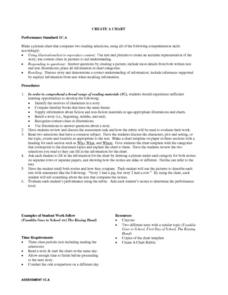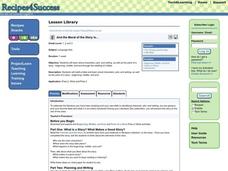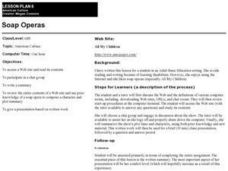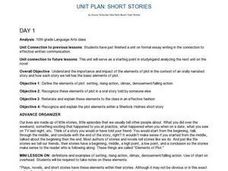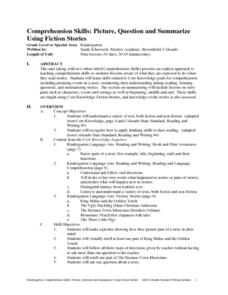Curated OER
Multimedia Book Reports
Learners read a chapter book of 100-200 pages in length. They create a story map and multimedia book report. Pupils review the elements of a story map such as: characters, setting, problem, important events, solution, etc.) Students...
Curated OER
Create a Chart
Students create charts for story elements. They read two selections that share a common theme and discuss the story elements. They create a chart for the characters, plot, and setting and complete it while reading the selections.
Curated OER
Graphing on a Coordinate Plane
Eighth graders explore the coordinate system. They identify the x and y-axis, parts of the coordinate plane, and discuss the process of plotting points. To emphasize the process of plotting points, 8th graders play an ordered pair...
Curated OER
Parts of a Story
Students read a short fiction book and demostrate comprehension by identifying the main characters, setting, conflict, theme, and summarizing the main points. They organize the information in Inspiration and create a powerpoint to show...
Curated OER
Plot and Conflict
Young scholars listen to a short story by Mildred Taylor entitled, "Song of the Trees." They focus on and discuss the elements of plot and conflict. They determine which events are examples of the central conflict and which elements of...
Curated OER
Introduction to Little House Books
Third graders identify the main characters in the Ingalls family and describe the relationships between the characters. They locate the setting of the book on a map of the Upper Mid- West. Students understand that the books are set in...
Curated OER
Literature: It's a Mad, Mad Macbeth
Students determine how the themes expressed in Macbeth are also applicable to contemporary society. They complete a series of written assignments demonstrating their comprehension of theme, content, and interpretation of the play....
Curated OER
Chocolate Chaos
Second graders demonstrate the ability to examine the elements of a story (theme, plot, setting, mood) and characters, by discussing and writing about each. They have fun with chocolate related activities and enjoy reading about some...
Curated OER
Faulkner's The Sound and the Fury: April Eighth, 1928: Narrating from an 'Ordered Place'?
Students describe Faulkner's use of time to structure the plot of The Sound and the Fury. They discuss the differences between first and third person narration and its effects on the novel. Discussion of the overall meaning is brought to...
Curated OER
Design a Book Cover
Students use the programs Pics4Learning and ImageBlender 3 to apply their knowledge of characters, plot, setting, symbolism, and conflict to design and create a book cover. Designed as a culminating literature activity.
Curated OER
And the Moral of the Story is...
Students discover the parts of a story through the retelling of a fable as well as characters, plot, and setting. This lesson is completed using the program Pixie to create an online storybook.
Curated OER
Identifing Elements of Narrative Writing
Students explore the concepts of narrative writing. They identify the basic elements in narrative writing such as the setting description, characters, conflict, climax and resolution. Using five adjectives from a previous spelling unit,...
Curated OER
Soap Operas
Students examine American culture through research on various soap opera websites. They access a soap opera website, participate in a chat group, evaluate the contents of the website, and write a summary of a character and plot.
Curated OER
We Can Work It Out
Learners practice conflict resolution by considering alternatives before reacting to a conflict.
Curated OER
Round Robin Suspense
Pupils, in groups, write suspense stories. At the end of a timed period, they pass the story to the next student to continue it. At the last writing session, the papers are returned to the originators and they share the stories with the...
Curated OER
Story Creation Magic: Character, Setting, Plot
Students review the terms plot, setting, and characters and examine how all of these elements are needed to make a story. They are given parts of stories and they try to identify all of those parts of the story.
Curated OER
Themes in Literature - Langston Hughes "Thank You Ma'm"
Eighth graders study Langston Hughes, "Thank You Ma'am" to discover the elements of plot, character motives and reactions. They express the effects of trust and kindness by writing a reflective personal narrative. They illustrate the...
Curated OER
Narrative Writing Outline
Students explore the elements of a narrative for its purpose, type of audience, mood, main character, minor characters, setting, and conflicts in the story. A story outline is developed and a five paragraph essay composed in this lesson.
Curated OER
Comparing Characters Across Two Short Stories
Ninth graders listen to a read aloud of two short stories focusing on literary devices. The write about the settings and realism of the stories, and decide each main character handles the conflict he faces with nature.
Curated OER
Unit Plan: Short Stories
Tenth graders complete a unit of lessons on the story elements of Sherlock Holmes short stories. They analyze the plot elements, complete graphic organizers, read and discuss the plots, observe a person and take notes, and analyze an...
Curated OER
Comprehension Skills: Picture, Question and Summarize Using Fiction Stories
Students build a variety of comprehension skills through the nine lessons of this unit. Picturing events, monitoring understanding during reading, forming questions, and summarizing stories form the core of the lessons being taught...
Curated OER
Tempest in the Lunchroom
Learners act out opening shipwreck scene of The Tempest, or watch and direct others doing it.
Curated OER
Character and Plot Development Through Comics
Third graders are introduced to character, plot development, point of view, and tone through the use of comic strips. They, in pairs, identify these four attributes in the comic strip and present their findings to the class.
Curated OER
Five Parts That Contribute to the Whole
Learners listen to and read an online story. Then they use a graphic organizer to learn the basic story elements. They select another online story and create a graphic organizer for its story elements.



